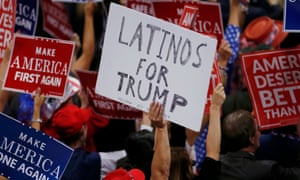Florida
Given the state’s notoriously close margin in elections – Trump carried the state over Clinton by 1.2% in 2016 – even the slightest swing could prove significant

Photograph: Carlo Allegri/Reuters
Donald Trump has routinely spoken of Hispanic immigrants in disparaging terms while pushing for a more restrictionist agenda on immigration.
But Democrats insist they are not taking support from Latinx voters for granted in the 2020 election – and are warning of the president’s potential to make inroads in the must-win state of Florida.
Democratic pollsters and allied groups recently convened in Washington to discuss the political landscape and expressed “legitimate concern” over Trump’s standing in Florida, where Latinx voters not only play an outsized role but also encompass more conservatives than in other battlegrounds.
“We expect Florida to be extremely close in 2020 and, if Democrats want to have a chance of beating Trump there, we’ll need to invest time and money early in communicating to Latino voters in the state,” Josh Schwerin, a spokesman for Priorities USA, a top Democratic Super Pac campaign group, told the Guardian.
“Democrats are going to have to earn the votes of Latinos and make the case for how the election impacts them, not just that it’s happening.”
Priorities USA, which spent more than $190m in the 2016 cycle, released new research analyzing the Latinx electorate.
The findings, which were presented in conjunction with the progressive political opinion group Latino Decisions, left little doubt that Latinx voters overwhelmingly support Democrats. It nonetheless cautioned that “there is a significant amount of work to be done” for Democrats to engage the crucial voting bloc.
According to the survey, Trump’s standing with Latinx voters sits at just 20% approval in Arizona and 26% in Nevada, where Democrats hope they can wrest victory from the Republicans, and where the Latinx electorate could wield substantial influence.
In Florida, where Latinos make up roughly 26% of the state’s population, Trump fares better with a 42% approval rating from Latinx voters. Trump’s numbers are bolstered in large part by support from Cubans, who have historically leaned Republican.
Given Florida’s notoriously close margins in elections – Trump carried the state over Hillary Clinton by just 1.3% in 2016 – even the slightest swing within the Latinx electorate could prove significant.
“In Florida, there should be an all-out effort to connect with Latino voters on the Democratic side and not give up any ground at all,” said Matt Barreto, the executive director of Latino Decisions.
“There’s a very legitimate concern and an important concern there.”

The Trump campaign unveiled its own efforts to woo the crucial voting bloc last month with a keen eye on Florida. In a swing through Miami, the vice-president, Mike Pence, formally launched a Latinos for Trump coalition, while Trump sat down with Telemundo in his first interview with a Spanish-language television network since taking office.
“Latino Americans know better than most about the cost of socialism,” Pence said during his speech in Miami. “It’s impoverished generations and stolen the liberty of millions.”
The Trump administration has taken particularly aggressive measures in Venezuela, imposing stiff sanctions on Nicolás Maduro’s regime amid a deepening crisis within the country. Earlier this year, Trump publicly recognized the opposition leader, Juan Guaidó, as the interim president of Venezuela, while rebuffing desperate Venezuelans seeking asylum in the US.
It’s a calculus Trump has looked to wield to his advantage in Florida, where he and his allies have run targeted ads casting Democrats as “socialists”. The message, they hope, will resonate with constituencies, such as Venezuelans and Nicaraguans, who have fled oppressive regimes, and harden Trump’s support from the older Cuban population.
“One of the key things here is that Trump cannot win the election without Florida,” said Franco Caliz-Aguilar, a senior political adviser at the pro-immigration advocacy group Community Change. “They take the possibility of sneaking votes off the Democratic party side of the table really, really seriously, because they don’t have a path to victory without Latinos in Florida.”
Democrats and their ally groups say they are building a much more robust Latinx outreach program in Florida that includes hiring more bilingual staffers and investment in Spanish-language media.
Democrats are also hoping to boost turnout among Latinx voters by highlighting the draconian policies Trump has pursued as president.
In 2017, Trump rescinded protections for millions of young, undocumented immigrants, known as Dreamers, who were brought to the US unlawfully as children. He has attempted to end a program granting temporary legal status to hundreds of thousands of immigrants from El Salvador, Haiti, Nicaragua and Sudan. And just last month, Trump took action to eliminate nearly all asylum claims for the countless migrants fleeing poverty and violence in Central America, currently blocked only by legal action.
The ramifications of Trump’s most controversial move on immigration – the so-called “zero tolerance” policy that led to the separation of thousands of families at the US-Mexico border – have also spilled into full view. The conditions at migrant detention facilities have been derided as squalid and inhumane, drawing comparisons to concentration camps.
There is also Trump’s widely pilloried response to the hurricane that ravaged Puerto Rico in 2017 and the implications for Florida, which is home to more than a million Puerto Ricans.
Trump infamously launched his 2016 presidential bid by declaring most Mexican immigrants were either rapists or drug traffickers.
As a candidate, he went on to question the impartiality of a Hispanic judge, called for sweeping deportations of undocumented immigrants and made building a wall along the US-Mexico border the central promise of his campaign. His rallies routinely featured victims of family members who were killed by an undocumented immigrant – a deliberate effort to tie immigrants to crime despite studies showing immigrants are less likely to commit crime than the native-born US population.
Top Republican leaders wondered aloud if Trump might damage the Republican party’s relationship with Latinx voters beyond repair. When the 2016 election came to pass, less than 30% of Latinx voters supported Trump at the polls.
The numbers were, however, on par with those of Mitt Romney, the 2012 Republican presidential nominee, who struggled with immigration but did not cut nearly as controversial a figure as Trump.
“I thought his campaign rhetoric was offensive and he would pay a bigger price, but I really didn’t see him suffering percentage-wise compared to John McCain and Mitt Romney’s number,” said Al Cárdenas, a Republican lobbyist who and former head of the Florida GOP.
“I grow more offended by the day, and I honestly don’t see how if you’re of Hispanic origin you’re not taken back by the resulting hatred and racism,” Cárdenas added.
But not all Latinx voters are directly affected by Trump’s restrictive measures on immigration, Cárdenas noted. And if the economy remains stable under Trump’s watch, the bloc of voters who are uncomfortable with his rhetoric might be willing to once again look the other way if they feel personally better off.
Recent polls have found Trump’s overall support among Latinx voters fluctuating between 18% and 27%. Data from the 2018 midterm elections suggested the percentage of Latinx voters who cast their ballots for Republicans was similar to Trump’s numbers in 2016.
In Florida, several statewide elections fell within such close margins that they triggered an automatic recount. Among them was the high-profile US Senate race, which saw the Republican Rick Scott elected by just over 10,000 votes, bolstered in part by Puerto Rican voters in central Florida.
“Republicans don’t necessarily have to win over a whole constituency, but just a few percentage points in some key counties can really make a difference in Florida,” said Andrea Mercado, the executive director of New Florida Majority, a progressive political organizing group.
Her message to Democrats was simple.
“The work of engaging in communities early and often is going to be critical and a game-changer,” Mercado said.
Source: Elections - theguardian.com




